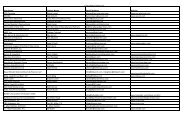Agriculture and Farmland Protection Plan - Town of Liberty
Agriculture and Farmland Protection Plan - Town of Liberty
Agriculture and Farmland Protection Plan - Town of Liberty
You also want an ePaper? Increase the reach of your titles
YUMPU automatically turns print PDFs into web optimized ePapers that Google loves.
Draft <strong>Town</strong> <strong>of</strong> <strong>Liberty</strong> <strong>Agriculture</strong> <strong>and</strong> Farml<strong>and</strong> <strong>Protection</strong> <strong>Plan</strong><br />
convenience retail are also allowed. The <strong>Town</strong> should<br />
review this use list to determine if these uses are<br />
compatible long-term <strong>and</strong> cumulatively with agriculture.<br />
Several agri-businesses are allowed with special use<br />
permits (farm equipment sales, stables <strong>and</strong> riding<br />
academy, feed <strong>and</strong> fertilizer businesses, for example <strong>and</strong><br />
no definitions are included to describe these uses. Single<br />
family clusters are allowed in the RD district but there are<br />
no definitions, st<strong>and</strong>ards, or procedures outlined.<br />
c. AC district adequately addresses ag uses: uses as listed<br />
allows for a variety <strong>of</strong> ag operations, <strong>and</strong> agri-businesses<br />
in the AC district.<br />
b. Density: The Buildout analysis shows that zoning creates a<br />
potential for 28,000 new homes (or 17,500 with all the<br />
environmental constraints removed from the density<br />
calculation). Up to 3,000 <strong>of</strong> these could be in the AC district <strong>and</strong><br />
about 15,000 could be in the RD district. Most farml<strong>and</strong>s are<br />
found within the AC district. The <strong>Town</strong> will need to evaluate<br />
whether this level <strong>of</strong> development is consistent with what they<br />
want for their community <strong>and</strong> whether agriculture can co-exist<br />
with this level <strong>of</strong> residential development. Long-term, it is<br />
unlikely that this level <strong>of</strong> development would sustain agricultural<br />
l<strong>and</strong> uses. As such, consider reducing the overall capacity <strong>of</strong><br />
development, especially in the AC district. The Comprehensive<br />
<strong>Plan</strong> already recommends reduction <strong>of</strong> density in the proposed<br />
AC district: A 10 acre minimum lot size or a 3 acre minimum lot<br />
size with 50% open space preserved if a conservation<br />
subdivision is developed. This is a very viable option for the<br />
<strong>Town</strong> to consider adopting. Other tools that could be considered<br />
by <strong>Liberty</strong> include:<br />
1. Use Average Lot Size Density: Do not require a minimum lot<br />
size, but instead rely on an average density to be attained<br />
over the entire parcel being developed. A 10-acre parcel may<br />
adequately reduce development pressures on farml<strong>and</strong>, but<br />
may also be very unaffordable for young <strong>and</strong> working<br />
families. Use <strong>of</strong> an average lot size however, is much more<br />
flexible, allows smaller lots to be created <strong>and</strong> leaving more<br />
opportunity for preservation <strong>of</strong> open space. While the cluster<br />
provisions <strong>of</strong> zoning will work best on major developments,<br />
use <strong>of</strong> average lot density will assist with preservation <strong>of</strong><br />
farml<strong>and</strong> <strong>and</strong> open space on smaller subdivisions as well.<br />
Page 85




